全文HTML
--> --> -->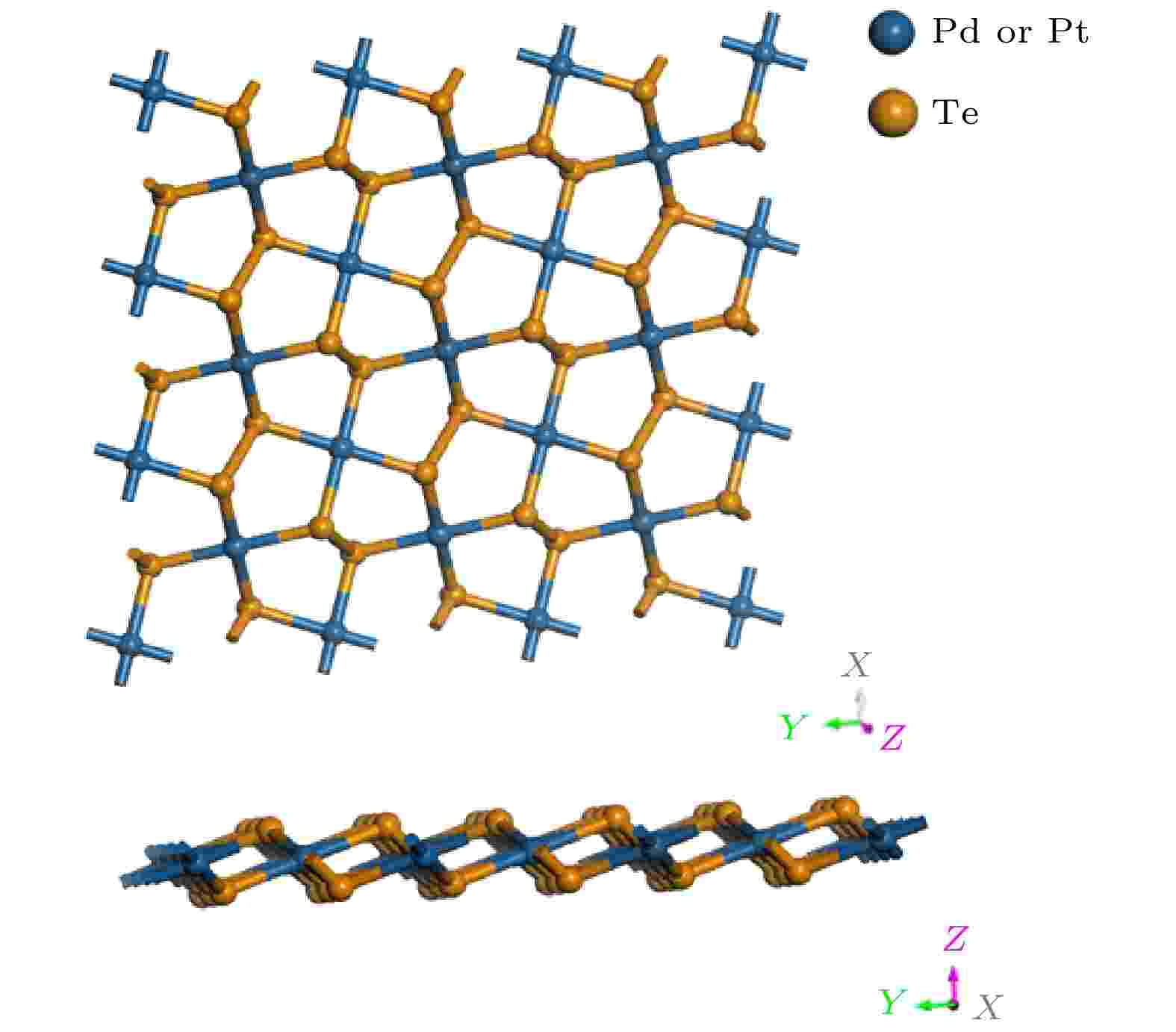 图 1 XTe2 (X = Pd, Pt)单层结构的顶视图和侧视图
图 1 XTe2 (X = Pd, Pt)单层结构的顶视图和侧视图Figure1. Top and side views of XTe2 (X = Pd, Pt) monolayers
| Materials | Results | a/? | b/? |
| PdTe2 | Present | 6.437 | 6.145 |
| Calc. | 6.44[8], 6.439[35] | 6.14[8], 6.147[35] | |
| PtTe2 | Present | 6.423 | 6.12 |
| Calc. | 6.44[36] | — |
表1XTe2 (X = Pd, Pt) 单层的晶格常数(a, b)
Table1.The optimized lattice parameters (a, b) of XTe2 (X = Pd, Pt) monolayers.
XTe2 (X = Pd, Pt)的声子色散图如图2所示. XTe2单层的声子谱在高对称方向上没有虚频, 说明优化后的结构具有热力学稳定性. PdTe2和PtTe2单层声子振动的最高频率分别为6.33, 5.82 THz, 与已有结果6.09, 5.24 THz相吻合[16,36]. PdTe2, PtTe2单层的声子振动最高频率低于常见热电材料PdS2和PdSe2的声子振动频率. 两种材料的声子振动最高频率较低, 则声学分支频率也相应较低. 由于晶格热导率依赖于声学分支, 表明这两种材料的晶格热导率可能低于其他常见热电材料. PtTe2的声子振动频率低于PdTe2的声子振动频率, 这是因为元素Pt的原子质量比Pd更大, 会抑制声学支频率. 这意味着PtTe2可能比PdTe2有更低的晶格热导率, 更优异的热电性能. XTe2 (X = Pd, Pt)材料的能带结构如图3 (a), (b)所示. 层状PdTe2, PtTe2属于间接带隙半导体材料, 价带顶部的能带相比导带底部的能带来说更为陡峭. 计算得到的带隙值分别为1.24, 1.38 eV, 与已有PdTe2的计算结果1.24 eV吻合[8].
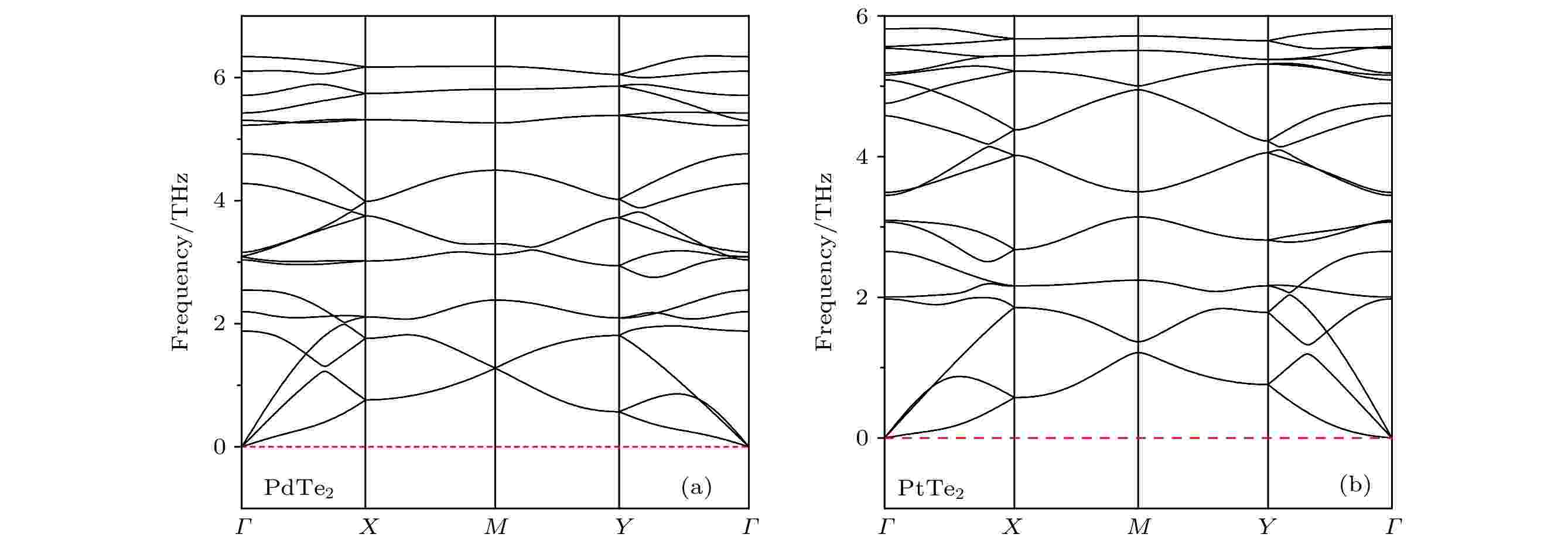 图 2 PdTe2 (a)和PtTe2 (b)的声子色散图
图 2 PdTe2 (a)和PtTe2 (b)的声子色散图Figure2. Calculated phonon dispersion curves of PdTe2 (a)and PtTe2 (b).
 图 3 PdTe2 (a)和PtTe2 (b)单层沿布里渊区高对称方向的能带结构
图 3 PdTe2 (a)和PtTe2 (b)单层沿布里渊区高对称方向的能带结构Figure3. Calculated energy-band structure of layered PdTe2 (a) and PtTe2 (b) along high-symmetry directions of the Brillouin zone.
晶格热导主要源于声子间的非谐效应, 是声子模式热导贡献的总和. 每一支声子模式的热导与声子群速度有关, 与声子群速度的平方成正比. 通过声子谱计算了声子群速度, 如图4所示. 图4展示了声学分支3种模式: LA (纵声学支), TA (横声学支)和ZA (平面外的声学支)的声子群速度. 声子群速度ZA分支小于TA和LA分支. 对于层状结构, ZA分支的频率依赖于波矢, 二次声子分支在许多非应变二维材料中普遍存在, 是ZA支靠近Г点时非线性离散的可能原因[37].
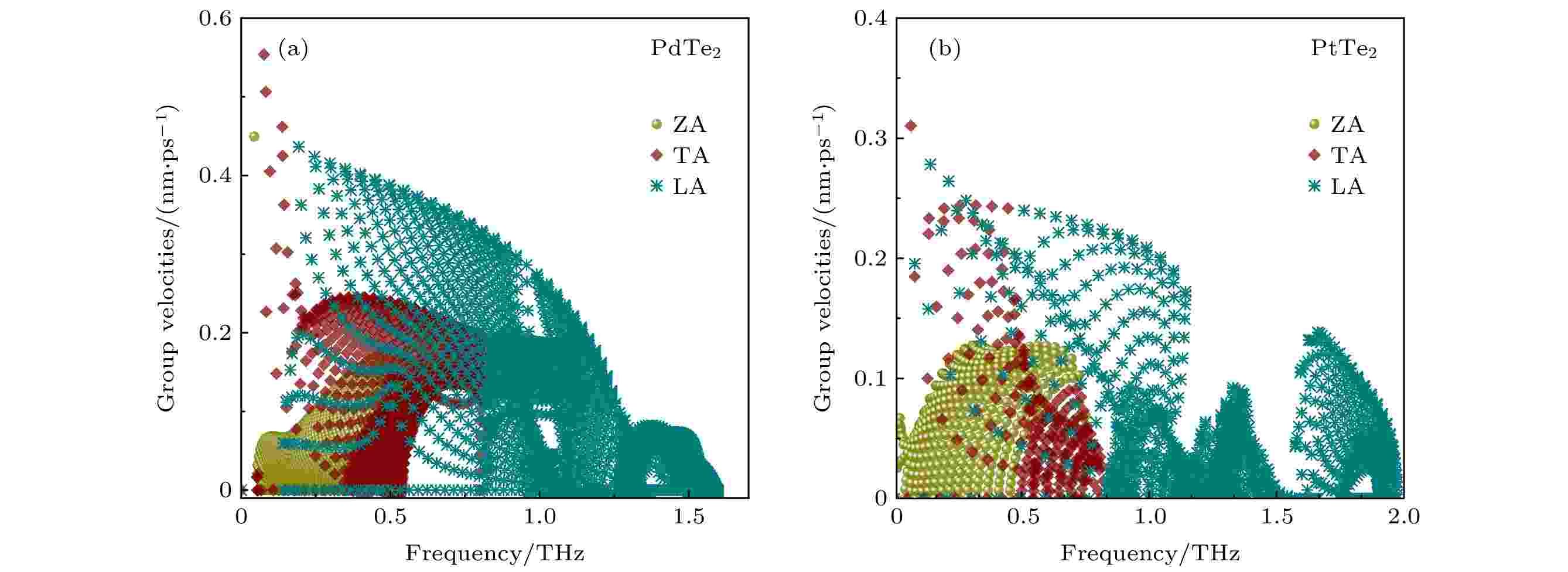 图 4 单层PdTe2 (a)和PtTe2 (b)群速度的三支声学分支(LA, TA 和ZA)随频率的变化
图 4 单层PdTe2 (a)和PtTe2 (b)群速度的三支声学分支(LA, TA 和ZA)随频率的变化Figure4. Variation of group velocity of three acoustic branches (ZA, TA, LA) with the frequency of PdTe2 (a) and PtTe2 (b) monolayers.
通常来说, 具有褶皱结构的二维材料打破了平面外的对称性, 增加了非谐声子的散射, 进而降低晶格热导[38]. 温度为300 K时, PdTe2和PtTe2总声子散射率随频率的变化如图5所示. 当声子频率较低时, ZA, TA和LA声学分支的声子散射率随声子频率的增大而增大, ZA分支的声子色散率最小. 高频部分的光学分支散射范围较大, 3个声学支声子散射率远远小于光学支的声子散射率. PtTe2的声子散射率比PdTe2的更大, 更离散, 导致了PtTe2的声子寿命比PdTe2更短, 进而可能导致PtTe2的晶格热导相对较小.
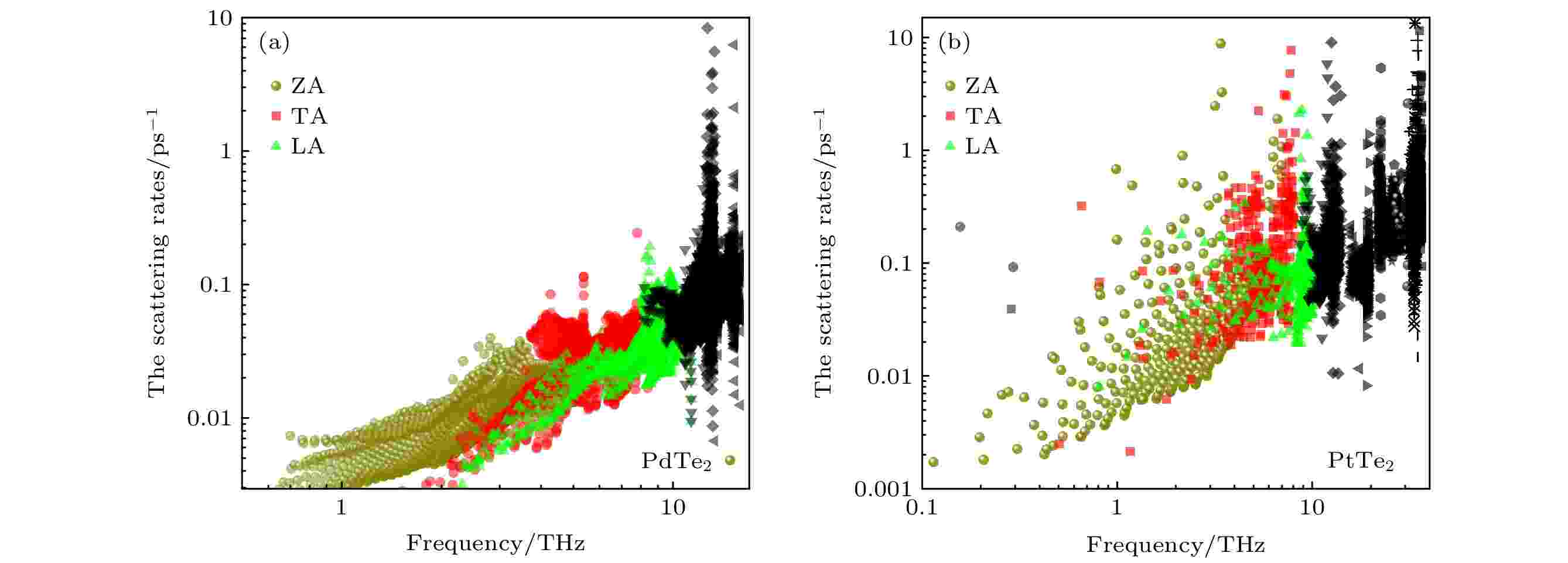 图 5 室温下PdTe2 (a)和PtTe2 (b)单层的声子色散率随频率的变化关系, LA, TA 和ZA为三支声学分支
图 5 室温下PdTe2 (a)和PtTe2 (b)单层的声子色散率随频率的变化关系, LA, TA 和ZA为三支声学分支Figure5. Phonon scattering rates of PdTe2 (a) and PtTe2 (b) monolayers at room temperature, where ZA, TA and LA are acoustic branches.
热导率是影响材料热电性能的重要因素, 热电性能表现优异的材料通常具有较低的热导率. 通过求解玻尔兹曼输运方程可以得到PdTe2和PtTe2材料的热导率[28]. 材料的晶格热导率随温度的变化率如图6 (a)所示. 随着温度的升高, 声子的平均自由程会大幅减小, 晶格热导率随温度的升高而降低, 同时表现出x, y方向的各向异性. 在300 K时, PdTe2在x, y方向晶格热导率分别为3.95和2.70 W/(m·K). PtTe2单层在x, y方向晶格热导率分别为3.27和1.04 W/(m·K), PtTe2的晶格热导率低于PdTe2. 由Wiedemann-Franz 定律可以得到电子热导率. 我们对比了PdTe2和PtTe2晶格热导率及电子热导率, 展示了总热导率随温度变化的情况, 如图6 (b), (c)所示. 随着温度升高, 自由电子运动加快, 热电子扩散迅速, 电子热导率升高. 电子热导率随温度升高而增大, 与晶格热导率随温度的变化关系呈相反的趋势. 计算出来的总热导率情况表明, 低温时, 晶格热导率对总热导率的贡献占据主导地位. PdTe2 和PtTe2在300 K的总热导率分别为4.22和2.2 W/(m·K). 对比发现, PtTe2具有更低的热导率, 可能具有比PdTe2更优异的热电性能.
 图 6 (a) PdTe2和PtTe2层状材料的晶格热导率沿x, y方向随温度的变化率; PdTe2 (b)和PtTe2 (c) 晶格热导率, 电子热导率及总热导率随温度变化的关系
图 6 (a) PdTe2和PtTe2层状材料的晶格热导率沿x, y方向随温度的变化率; PdTe2 (b)和PtTe2 (c) 晶格热导率, 电子热导率及总热导率随温度变化的关系Figure6. (a) Calculated lattice thermal conductivity of monolayer PdTe2 and PtTe2 along the x (dark dashed line) and the y (red dashed line) directions and from 200 K to 800 K with the interval of 100 K; thermal conductivity of PdTe2 (b) and PtTe2 (c) at different temperatures, where ke is electron thermal conductivity, kl is lattice thermal conductivity, and ke + kl is total thermal conductivity.
在热电材料中, 载流子和声子之间的散射被认为是主要的散射机制, 其弛豫时间依赖于散射机制. 采用形变势理论计算得到的有效弹性模量C2D、输送方向有效质量m*、形变势常量El、弛豫时间τ及载流子迁移率μ, 如表2所示. p型掺杂时, PdTe2在x, y方向的形变势常量El分别为3.6, 3.2 eV; n型掺杂时分别为5.5, 4.6 eV. 跟已有结果(p型) 3.972, 2.631 eV (n型) 5.286, 4.081 eV吻合[35]. 结果显示, XTe2 (X = Pd, Pt)的弛豫时间具有较强的各向异性, 并且p型掺杂时的弛豫时间高于n型掺杂时, 这很可能导致两种掺杂方式的热电性能有所差异. 载流子迁移率的结果也可以说明这个情况, 空穴迁移率比电子迁移率更大, 更可观. 因此材料p型掺杂时的热电性能可能更为优异.
| PdTe2 | x | y | PtTe2 | x | y | ||||||
| p | n | p | n | p | n | p | n | ||||
| C2D/(eV·?–2) | 4.86 | 3.90 | 4.75 | 5.84 | |||||||
| El/eV | 3.6 | 5.5 | 3.2 | 4.6 | 2.65 | 3.83 | 3.9 | 6.4 | |||
| m*/me | 0.88 | 0.58 | 0.88 | 0.58 | 0.44 | 0.33 | 0.46 | 0.29 | |||
| μ/(cm2·V–1·s–1) | 162 | 157 | 168 | 183 | 1150 | 1071 | 630 | 546 | |||
| τ/(10–14 s) | 8.2 | 5.3 | 8.5 | 6.1 | 28.9 | 20.3 | 16.6 | 8.9 | |||
表2温度为300 K时, PdTe2和PtTe2的有效弹性模量C2D、形变势常量El、有效质量m*、载流子迁移率μ及弛豫时间τ
Table2.Calculated elastic modulus C2 D, DP constant El, effective mass (m*), carrier mobility (μ), and relaxation time (τ) at 300 K of PdTe2 and PtTe2 monolayers.
通过求解电子玻尔兹曼输运方程[27], 我们计算了XTe2 (X = Pd, Pt)的电输运参数, 如: 电导率与弛豫时间的比值(σ/τ), Seebeck系数(S)等. 电导率与弛豫时间的比值随载流子浓度及时间的变化如图7所示. σ/τ 的值随载流子浓度的增大而增大, 也随温度的升高而增大, 温度变化对σ/τ 变化率的贡献远小于载流子浓度的贡献. 对于PdTe2单层, p型掺杂时, 各向异性对σ/τ 的影响不明显; n型掺杂时, σ/τ 沿x方向上的值远大于y方向的值. 对于PtTe2单层, p型掺杂时, 各向异性对σ/τ 的影响同样不明显; n型掺杂时, σ/τ 沿y方向上的值大于x方向的值.
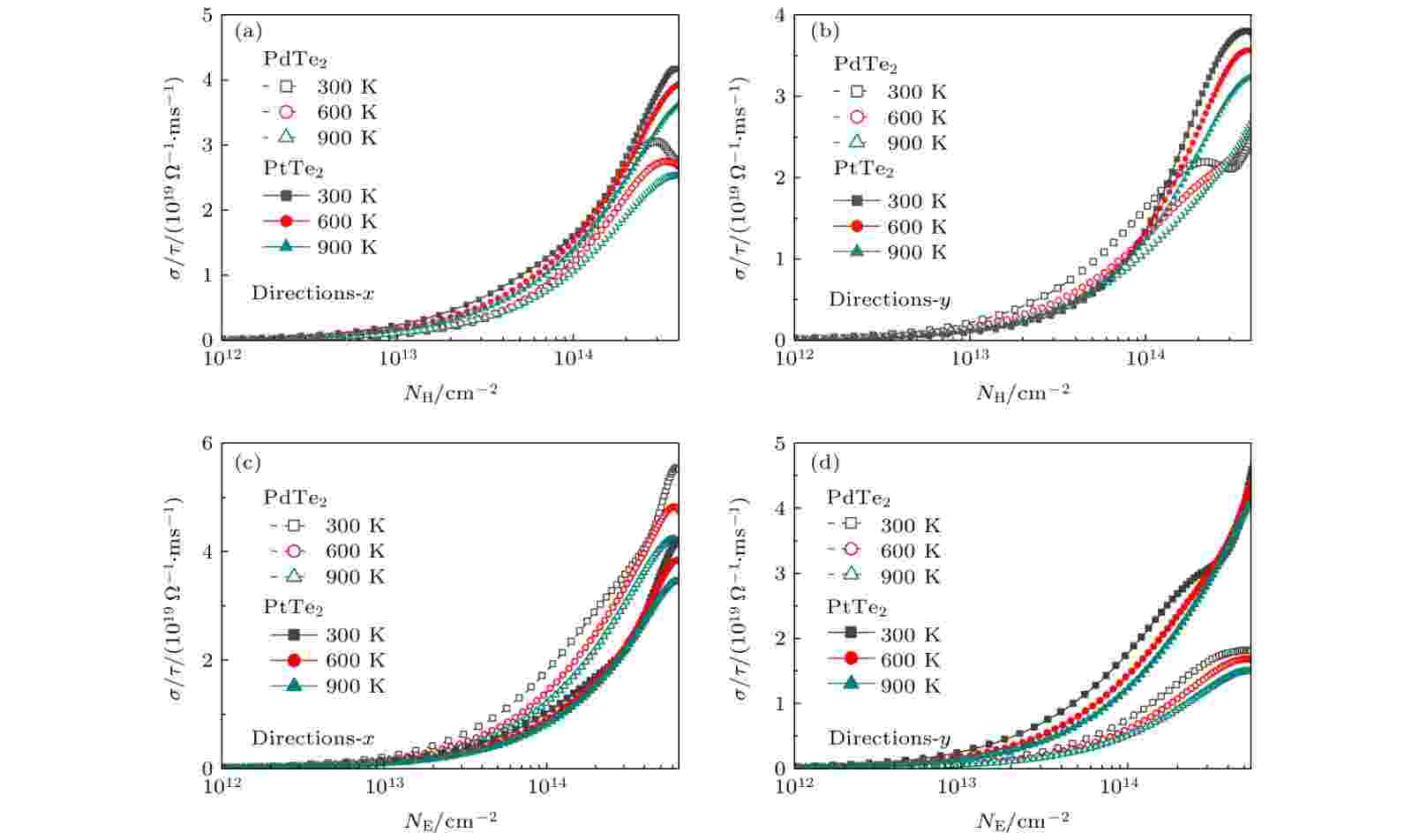 图 7 p型掺杂时, PdTe2 (a)和PtTe2 (b)两种材料在不同温度下沿x, y两个方向σ/τ 随载流子浓度的变化. n型掺杂时, PdTe2 (c)和PtTe2 (d)两种材料在不同温度下沿x, y两个方向σ/τ 随载流子浓度的变化
图 7 p型掺杂时, PdTe2 (a)和PtTe2 (b)两种材料在不同温度下沿x, y两个方向σ/τ 随载流子浓度的变化. n型掺杂时, PdTe2 (c)和PtTe2 (d)两种材料在不同温度下沿x, y两个方向σ/τ 随载流子浓度的变化Figure7. Calculated electrical conductivity of p-type (a), (b) and n-type (c), (b) monolayer PdTe2 and PtTe2 along the x and the y directions from 300 K to 900 K with the interval of 300 K.
不同温度下塞贝克系数S随载流子浓度变化的关系如图8所示, S随载流子浓度的增加而减小, 随温度的增加而增大. 温度变化对S的影响较小. 从表1结果中可以看出, 不同方向的有效质量相差较大, 但不同传输方向的塞贝克系数却相差较小, 说明XTe2 (X = Pd, Pt)在电子输运性质上表现较弱的各向异性. 当温度为300 K时, p和n型掺杂的PdTe2 单层S值最大值分别可以达到694, 728 μV/K; p和n型掺杂的PtTe2 单层S值最大值可以达到706, 681 μV/K. 塞贝克系数和电导率对材料转换效率有极大的影响.
 图 8 p型掺杂时, PdTe2 (a)和PtTe2 (b)两种材料在不同温度下沿x, y两个方向的塞贝克系数S随载流子浓度的变化. n型掺杂时, PdTe2 (c)和PtTe2 (d)两种材料在不同温度下沿x, y两个方向的塞贝克系数S随载流子浓度的变化
图 8 p型掺杂时, PdTe2 (a)和PtTe2 (b)两种材料在不同温度下沿x, y两个方向的塞贝克系数S随载流子浓度的变化. n型掺杂时, PdTe2 (c)和PtTe2 (d)两种材料在不同温度下沿x, y两个方向的塞贝克系数S随载流子浓度的变化Figure8. Calculated Seebeck coefficient S of p-type (a), (b) and n-type (c), (d) monolayer PdTe2 and PtTe2 along the x and the y directions from 300 to 900 K with the interval of 300 K.
热电材料的转换效率由ZT值来定量描述, 可以根据计算公式
 图 9 p型掺杂时PdTe2 (a)和PtTe2 (b)两种材料在不同温度下沿x, y两个方向ZT值随载流子浓度的变化. n型掺杂时PdTe2 (c)和PtTe2 (d)两种材料在不同温度下沿x, y两个方向ZT值随载流子浓度的变化
图 9 p型掺杂时PdTe2 (a)和PtTe2 (b)两种材料在不同温度下沿x, y两个方向ZT值随载流子浓度的变化. n型掺杂时PdTe2 (c)和PtTe2 (d)两种材料在不同温度下沿x, y两个方向ZT值随载流子浓度的变化Figure9. Calculated ZT values of p-type (a), (b) and n-type (c), (d) monolayer PdTe2 and PtTe2 along the x and the y directions from 300 K to 900 K with the interval of 300 K.
从热输运性能方面来说. 声学支振动对晶格热导率产生主要影响. 元素Pt的原子质量比Pd大, 抑制了声学支频率; PtTe2的色散率比PdTe2更大, 更离散, PtTe2单层的声子寿命比PdTe2更短. 这两个原因使得PtTe2具有更低的晶格热导率. PdTe2和PtTe2单层的晶格热导率随温度的升高而降低, 且表现出x, y 方向的各向异性. 电子热导率随温度升高而增大, 与晶格热导率随温度的变化关系呈相反的变化趋势, 这是由于温度升高后, 自由电子运动加快, 热电子扩散变得迅速. 从结果来看, 低温时, 晶格热导率对总热导率做主要贡献, PtTe2的总热导率也低于PdTe2, PtTe2具有更为优异的热电性能.
从电输运性能方面来说. 两种材料的电导率与弛豫时间的比值σ/τ、塞贝克系数S等具有各向异性. 较高的载流子迁移率、电导率及塞贝克系数值, 展示出材料较优异的热电性能. 材料p型掺杂的热电性能优于n型掺杂. 对比PdTe2和PtTe2单层的ZT值, 发现PtTe2的ZT值更高, 当温度为300 K时, PtTe2的ZT峰值可以达到2.75. 因此PtTe2是比PdTe2更优异的热电材料, 热电转换效率非常可观.
